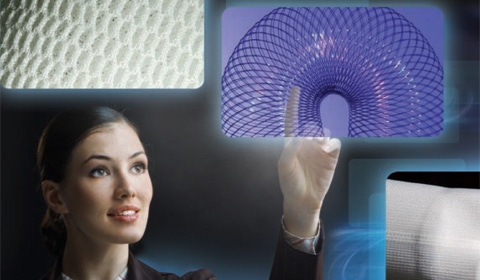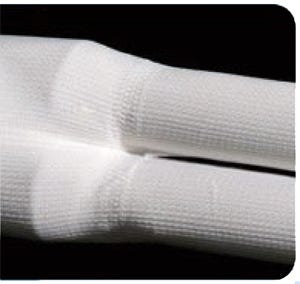Textile Forming Technology Leads Material Future
During the past five years an increasing variety of novel applications in the cardiovascular, orthopedic, tissue engineering, and neurology market segments began using implantable textiles (also called biomedical textiles).
September 21, 2011

The term textiles typically evokes images of blue jeans and bed linens. However, the medical community has been adapting industrial textile technology to produce components for medical products such as vascular grafts and hernia meshes commercially for more than 50 years. During the past five years an increasing variety of novel applications in the cardiovascular, orthopedic, tissue engineering, and neurology market segments began using implantable textiles (also called biomedical textiles). Advanced device designs manipulate unique material characteristics and the design flexibility imparted by the textile forming technology to achieve novel textile structures for implants.
Material Selection
|
Biomedical textiles are a unique materials platform for devices. They provide flexibility, porosity, conformability, and compaction—characteristics that mimic natural tissue responses within the body. Depending on the desired device mechanics, a designer can use polymeric or metallic yarns or wires (such as monofilaments or multifilaments), which are then formed into woven, knitted, braided, or nonwoven structures.
Although nonabsorbable materials such as polypropylene (PP) and polyethylene terephthalate (PET; polyester) are more commonly used in implantable medical devices today, the use of polyetheretherketone (PEEK) and polytetrafluoroethylene (PTFE) is increasing in regularity. To achieve varying degrees of degradation over time, designers can choose textiles made with a wide array of degradable polymers including polyglycolides, polylactides, and other copolymers, which can be used independently or combined with nonabsorbables depending on the application.
Metals such as nitinol, cobalt chrome, stainless steel, platinum, titanium, and tantalum are commonly used in medical devices such as vascular stents, distal protection, and emboli retrieval devices, to name a few. These metals can provide additional strength, stability, and durability to devices that require reinforcement such as extruded tubing for fluid transfer and device delivery. Platinum and tantalum are radiopaque—when used in devices, they can be located and tracked on a screen during minimally invasive surgery. When used in a knitted structure, stainless steel can create a stretchy metal that is soft and supple to the touch.
To expedite the design cycle and ease the regulatory approval process, many material suppliers have an approved master file on record at FDA to demonstrate the processes, controls, and formulation of a material. Since regulatory agencies are familiar with the more commonly used materials (PET, PTFE, and PP), some device designers use hybrid and composite structures rather than trying to qualify an entirely new material.
Forming Techniques: Flexibility and Choice
Knitted structures are formed by interlocking loops of yarn or metal by tying knots in a series in either a weft (transverse stitching) or warp (longitudinal stitching) pattern. These two techniques, defined by the orientation of the materials (called the stitch pattern), have very different properties and provide a wide cross section of design opportunities. This diversity in properties allows flexibility in creating flat, broad, or tubular structures that can be compressed and inserted into small cavities via a catheter or designed to interact with surrounding tissue.
Although there are exceptions depending on the combination of materials used, knitted materials are generally porous and highly conformable (meaning they create smooth, even contact to fit the shape of nonuniform anatomical structures). Knitted materials are also elastic with high burst and tensile properties. The looping and overlapping patterns create a surface area and open space that yields high in-growth potential. The rate of adhesion—the time period required for the textile to adhere to the tissue surface—can be further controlled with material coatings that can slow or prevent responses on certain sides of the textile or in certain locations of the body.
Knitted devices provide elasticity and cavity-filling bulk, and create complex surface configurations by selectively modifying length and width characteristics. These inherent properties have made knitted structures suitable for use in vascular prostheses, hemostasis products, hernia meshes, adhesion barriers, and incontinence devices. Current development efforts are focused on leveraging the unique biphasic loading properties of knitted structures in tensile load bearing applications for orthopedic applications. These structures can be designed to create components that respond by stretching during initial loading followed by a “soft” stop when the load increases to a desired end point.
Woven fabrics are created by interlacing yarns or wires in an over-under perpendicular pattern. With careful selection of the raw materials, plain, twill, and satin patterns can be combined to address certain needs. For example, diagonal twill formations are well suited for abrasion, whereas satin designs are soft and smooth. Woven designs offer the most shape diversity among the textile forming technologies and can be created as flat, tubular, or near-net shape fabrics.
Because of their geometry, woven fabrics have low porosity and are ideally suited for containing fluids, and for filtration and fluid transfers. They support high tensile loads in applications such as orthopedic joint repairs, endovascular aneurysm repairs, and spinal tethers. Woven fabrics are dense and dimensionally stable and can be designed with multilumen (side-by-side, circular, tapering, or bifurcating) and fenestration features. Currently, low-profile woven fabrics can be as thin as 40 to 50 µm. However, designers are constantly pushing the thickness limit to squeeze more material into delivery systems such as catheters.
An arthroscopic rotator cuff repair is one example of how a woven design can improve an existing procedure. Typically the muscles are repaired with a double row of sutures that create stress points that can tear. A device designed to use an orthobiologic tissue scaffold can distribute the stress load, transform shape, and move with the surrounding muscles and tendons while promoting new tissue growth and encouraging healing. Overall recovery time is reduced, and the strength and longevity of the overall repair is improved.
An up-and-coming biomedical textile engineering technique that is widely used in industrial applications is called 3-D weaving. Using combinations of materials and hybrids in varying thicknesses and densities throughout the fabric structure to facilitate tissue engineering, materials can be integrally woven for long-term wear and durability (a constant concern in the medical device industry) yet still remain flexible enough to move with the body’s natural movements without delaminating.
|
3-D weaving is the latest biomedical engineering method that uses a combination of materials and hybrids that vary in thickness and density. |
For example, 3-D weaving of orthobiologic scaffolds promotes tissue growth on the device for long-term support, while also directing the growth in a specific manner by connecting multiple layers (i.e. one material will absorb over time and disconnect from the nonabsorbable material).
Braiding has the longest history as a textile forming technology. Braids are formed by intertwining three of more yarns or wires in a diagonally overlapping pattern, typically at 45° off the main access. Variables in a braided textile include the number of yarns or wires, angle of overlapping, number of interlacings per inch, and how they interrelate with each other.
Braided structures are often produced over mandrels to fix the internal diameter, create near-net shapes, and leverage geometric foreshortening. They are flexible, porous, and kink resistant to handle tight bends, designed with varying density. The structures have compaction capabilities and high radial expansion to accommodate high levels of torque. Commonly used as sutures, braided structures are also ideal for stents, minimally invasive surgery, neurovascular applications, catheter or trochar delivery, and other instrumentation.
A novel spinal stabilization system uses a robust, high-grade braided material in a device that offers an alternative to spinal fusion. Constructed with a spacer to protect the nerve, a screw and PET-braided cord can be anchored to the bone through a minimally invasive procedure.
Paper is one example of the original man-made nonwoven structures that are formed by bonding or interlocking fibers and filaments using mechanical, thermal, or chemical means. For medical devices, nonwoven designs with absorbable polymers are ideal for tissue scaffolds, medical felts and dressings, and active wound care products. Nonwoven structures tend to have high bulk with low weight, large amounts of void space, and fiber surface area that provide air and moisture permeability and high absorption capabilities. The major drawback of some nonwovens is that they have very low tensile and shear strength and often require some type of backing reinforcement.
Biomedical Textiles: The Pathway to Innovation
A basic fabric geometry platform is used to create composite properties with raw materials that are otherwise unobtainable. Performance biomaterials such as PEEK, ultrahigh-molecular-weight polyethylene, and absorbables become the enabling materials platform that enhances fabric with composite properties for specialized tissue response and biphasic mechanical properties.
Development with synthetic structures and tissue hybrids in load-bearing applications is currently underway, particularly in orthopedic applications such as tendon, ligament, and muscle repair. These devices combine a synthetic textile reinforcement with an increasingly diverse array of biologic materials to facilitate an engineered healing response. Biomedical textiles are also making inroads as osteoconductive materials and tissue-engineered scaffolds with varied porosity and materials, and in containment devices for bone morphogenetic proteins, demineralized bone matrices, and stem cell seeding. Exciting developments are attracting more research attention in the area of biologic fibers, such as collagen fibers. These biologic fibers have the promise of eliminating, or at least minimizing, the negative biologic responses associated with most currently available materials.
Conclusion
With a seemingly endless ability to customize materials and forming technologies to suit new device applications, combined with the R&D work occurring in the field, biomedical textiles offer a unique pathway for accelerating innovation and advancing medical technologies available for patient procedures.
In the near-term, the next generation of medical devices using textile technologies are currently in development in a wide range of applications in general surgery, advanced wound care, orthopedics, neurology, and cardiovascular. These devices have already had a significant effect on simplifying surgical techniques and improving patient outcomes. In the long-term, the biomedical industry is actively investigating and developing new biomaterials capable of working in tandem with the body’s natural healing process to engineer tissue response. Quite a few of these materials can be created into unique textile structures that can be formed using textile manufacturing techniques. It will be the combination of these materials and textile engineering technologies that enable innovation to reach the next plateau in advanced device design.
Ryan Heniford is development engineering manager at Secant Medical LLC (Perkasie, PA).
About the Author(s)
You May Also Like



